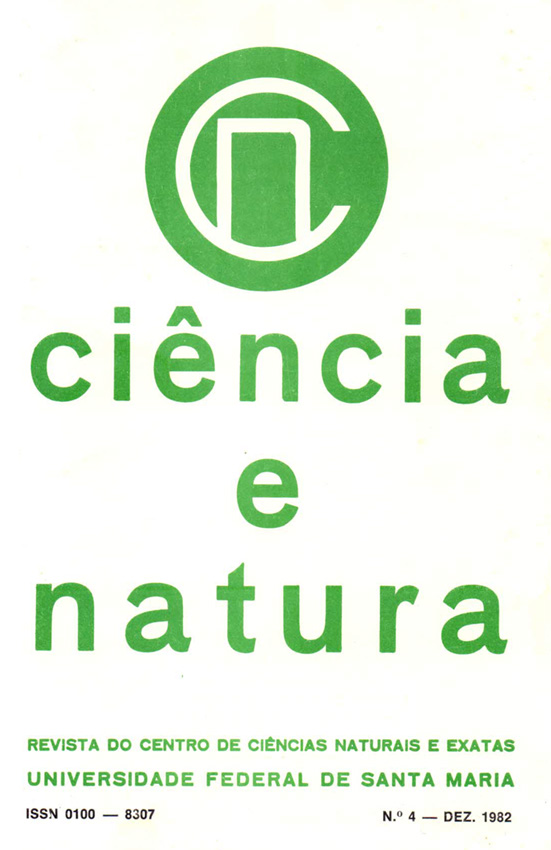Morfologia dos pêlos glandulares e aspectos fitoquímicos de Cannabis Sativa L., monóica
DOI:
https://doi.org/10.5902/2179460X24977Resumo
Fez-se descrição detalhada dos pêlos glandulares produtores de resina, de um exemplar monóico de Cannabis Sativa L. e a identificação fitoquímica, incluindo a cromatografia em camada delgada.Downloads
Referências
CALABRESE, A. I. & ASTOLFI, E. A., Marihuana. In: Toxicologia. Buenos Aires. Kapelusz, 1969. p. 267-8.
CALDAS, A., Chemical Identification of Cannabis. Anal. Chim. Acta, Netherlands, 49: 194, 1969.
CARAUTA, J.P.P., Canabáceas. Flora Ilustrada Catarinense , Santa Catarina, P. Raulino Reitz, 1975. 17p.
COSTA, O.A. & JACCOUD, R.J.S., Algumas considerações farmacognósticas referentes ao Cannabis sativa L.. Rev. Bras. Farm., Brasil, 48(1): 3-25, 1967.
FONT'QUER, P., Cannabáceas In: Plantas Medicinales El dioscorides Renovado. Barcelona, 2a. ed., 1973. p. 127-9.
HAMMOND, C.T. & MAHLBERG, P.G., Morphology of glandular hairs of Cannabis sativa from scanning electron microscopy. Amer. J. Bot. 60 (1): 524-8, 1973.
HAYWARD, Herman E., The structure of economic plants. New York, Macmillan Company, 1948.
KARNIOL, I.G. & CARLlNI, E.A., Comparative studies in man and in laboratory animals on Delta 8 - and Delta 9 – transtetrahydro cannabinol. Pharmacology. 9: 115-26. 1973.
KOHN, ABREST E. Précis de Toxicologie. 3a. ed., Paris, G. Doin, 1955.
LOPES, V.J.X. & LOPES A.M.V., Características morfológicas externas de uma planta monóica de Cannabis sativa L .. Ciência e Natura, Santa Maria, 1: 113-9, 1979.
MURAD, J.E. O que você deve saber sobre os psicotrópicos. A viagem sem bilhete de volta. Belo Horizonte, Minas Gráfica, 1972. 157p.
PRADO, A. B., Contribuição para o conhecimento da maconha brasileira. An. Farm. Quim., 10 (11 e 12):1-16,1959.
PEREIRA, J.R., Contribuição para o estudo das Plantas Alucinatórias, particularmente da Maconha (Cannabis sativa). Rev. Fl. Med., 12 ( 3 ): 1, 1 945.
SASS, J.E., Botanical microtechnique. 2a. ed., Iowa, The Iowa State College, 1951. 228 p.
SCHMIDT, I., A ilusão das drogas. 2a. ed., São Paulo, Publicadora Brasileira, 1976. 144 p.
SILVA, J.B. & ALVES, A., Análises Toxicológica, Santa Maria, Imprensa Universitária. 1979. 74p.
SMALL, E & CRONQUIST, A., A practical and natural taxonomy for Cannabis. Taxon. 25 (4): 405-35, 1976.
Downloads
Publicado
Como Citar
Edição
Seção
Licença
Para acessar a DECLARAÇÃO DE ORIGINALIDADE E EXCLUSIVIDADE E CESSÃO DE DIREITOS AUTORAIS clique aqui.
Diretrizes Éticas para Publicação de Revistas
A revista Ciência e Natura está empenhada em garantir a ética na publicação e na qualidade dos artigos.
A conformidade com padrões de comportamento ético é, portanto, esperada de todas as partes envolvidas: Autores, Editores e Revisores.
Em particular,
Autores: Os Autores devem apresentar uma discussão objetiva sobre a importância do trabalho de pesquisa, bem como detalhes e referências suficientes para permitir que outros reproduzam as experiências. Declarações fraudulentas ou intencionalmente incorretas constituem comportamento antiético e são inaceitáveis. Artigos de Revisão também devem ser objetivos, abrangentes e relatos precisos do estado da arte. Os Autores devem assegurar que seu trabalho é uma obra totalmente original, e se o trabalho e / ou palavras de outros têm sido utilizadas, isso tem sido devidamente reconhecido. O plágio em todas as suas formas constitui um comportamento publicitário não ético e é inaceitável. Submeter o mesmo manuscrito a mais de um jornal simultaneamente constitui um comportamento publicitário não ético e é inaceitável. Os Autores não devem submeter artigos que descrevam essencialmente a mesma pesquisa a mais de uma revista. O Autor correspondente deve garantir que haja um consenso total de todos os Co-autores na aprovação da versão final do artigo e sua submissão para publicação.
Editores: Os Editores devem avaliar manuscritos exclusivamente com base no seu mérito acadêmico. Um Editor não deve usar informações não publicadas na própria pesquisa do Editor sem o consentimento expresso por escrito do Autor. Os Editores devem tomar medidas de resposta razoável quando tiverem sido apresentadas queixas éticas relativas a um manuscrito submetido ou publicado.
Revisores: Todos os manuscritos recebidos para revisão devem ser tratados como documentos confidenciais. As informações ou ideias privilegiadas obtidas através da análise por pares devem ser mantidas confidenciais e não utilizadas para vantagens pessoais. As revisões devem ser conduzidas objetivamente e as observações devem ser formuladas claramente com argumentos de apoio, de modo que os Autores possam usá-los para melhorar o artigo. Qualquer Revisor selecionado que se sinta desqualificado para rever a pesquisa relatada em um manuscrito ou sabe que sua rápida revisão será impossível deve notificar o Editor e desculpar-se do processo de revisão. Os Revisores não devem considerar manuscritos nos quais tenham conflitos de interesse resultantes de relacionamentos ou conexões competitivas, colaborativas ou outras conexões com qualquer dos autores, empresas ou instituições conectadas aos documentos.






